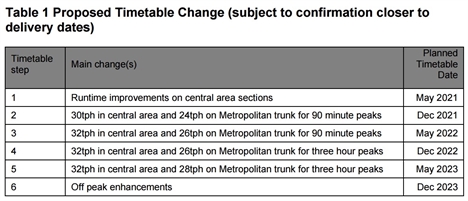15.06.15
Timetable released for SSR resignalling – LU’s ‘top priority’
Some of the timetable changes associated with the resignalling of the Sub Surface Railway (SSR) will not happen until the end of 2023, even later than originally thought.
The estimated final cost is £5.48bn, lower than the previously quoted £5.54bn. Of this, £3.37bn has already been spent (mostly on the S7 and S8 fleet replacement plus station upgrades and platform lengthenings), with 2015-16 spending alone forecast at £371m.
When the contract was Bombardier was scrapped and Thales was pre-selected instead, LU initially suggested it could still hit the 2018 deadline, though few industry observers thought this likely. As reported by RTM in April, the completion date was then pushed back to 2022.
Board papers going before TfL’s Finance & Policy Committee on Wednesday 17 June contain this revised schedule:

The report calls SSR resignalling “London Underground’s top priority” and says it will “provide a crucial contribution to the increased capacity of London’s transport network”.
The scope of the changes has been shifted and in many cases reduced, aimed at producing the hoped-for 33% capacity increase with fewer disruptive and potentially risky changes. For example, the Wimbledon branch of the District line, which is Network Rail managed, will now have an ATC signalling overlay rather than full resignalling, and Piccadilly Line trains will not be fitted with new signalling equipment. The signalling solution for the interoperable sections of the SSR and Piccadilly lines will include conventional signals to allow for continued operation of Piccadilly services on these sections.
These changes have also removed the need for some multi-week central London blockades, and allow some of the works to be combined with previously planned renewal works.
There have also been extensive changes to the governance and project management of the scheme, to avoid the problems associated with the previous Bombardier contract and to learn lessons from successful programmes, such as Crossrail. “A cultural transformation programme is now underway, with a strong collaboration focus,” the paper says. It also says the reviewed programme has incorporated “lessons learnt from the Northern Line Upgrade”. RTM reported in detail on some of these lessons in our April/May 2015 edition, including interviews with the key players at LU and Thales. That article is here. Many of the frontline and senior figures working on the Northern Line Upgrade will now work on the SSR project.
In the summer, LU will also appoint a programme support partner to “provide a core team to help support effective collaboration between all parties and drive efficiencies”.
The parts of the original programme that are not yet delivered
(a) completion of the roll-out of S Stock trains on the District Line;
(b) S Stock stabling, train maintenance and cleaning facilities at Ealing Common and Upminster depots;
(c) completion of power supply modifications;
(d) new Automatic Train Control (ATC) system incorporating Automatic Train Protection, Operation, Route Setting and Supervision to replace existing signalling;
(e) installation of associated signalling equipment on S Stock, engineering vehicles and heritage trains;
(f) fit-out of the Service Control Centre and Integration of signalling and other management systems, including train arrival information;
(g) signalling enabling works including power supply for the signalling system, equipment rooms and cable routes;
(h) track layout changes where necessary to enable higher trains per hour, reduce the capital costs of resignalling, improve journey times, and reduce whole life costs; and
(i) installation of signalling equipment to allow existing Piccadilly line trains to be manually operated under the protection of the new signalling system 4 where they operate over the same tracks as District and Metropolitan trains; to include installation of lineside signalling on the section of the Piccadilly line which links these two areas (Rayners Lane Junction to Hanger Lane).
Changes to the programme following the comprehensive review
(a) revisions to ATC programme scope to provide the interfaces with the Thales ATC system;
(b) revisions to the technical signalling solution on some of the sections where tracks are shared with other services: i. the Wimbledon branch of the District line, which is Network Rail managed, will now have an ATC signalling overlay rather than full resignalling (matching the established solution for the Richmond branch and consequently reducing design variants); ii. Piccadilly Line trains will not be fitted with new signalling equipment; iii. the section of the Piccadilly line between Rayners Lane Junction and Hanger Lane Junction will no longer be resignalled by the Programme; and iv. the signalling solution for the interoperable sections of the SSR and Piccadilly lines will include conventional signals to allow for continued operation of Piccadilly services on these sections. This solution will provide a suitable starting point for the subsequent New Tube for London Programme modernisation of the Piccadilly line;
(c) the number of planned track layout changes to be delivered by the Programme has been reduced following an extensive review, which has incorporated system modelling delivered as part of the ATC System Readiness project i. this has demonstrated that fewer changes are required to deliver the 33% capacity increase with the Thales signalling system; ii. changes to simplify the existing track layout and therefore minimise the cost of ATC have been retained; and iii. to reduce delivery risk, other previously planned track layout changes are to be delivered (subject to business case) after the commissioning of the ATC system, and outside of the Programme;
(d) addition of a package of platform works to reduce the stepping distance between trains and platforms; and
(e) additional long term, S Stock train overhaul capability at Neasden Depot
Source: TfL Finance & Policy Committee, 17 June 2015, 'Modernisation of the District, Metropolitan, Circle and Hammersmith & City lines, and Automatic Train Control Contract'